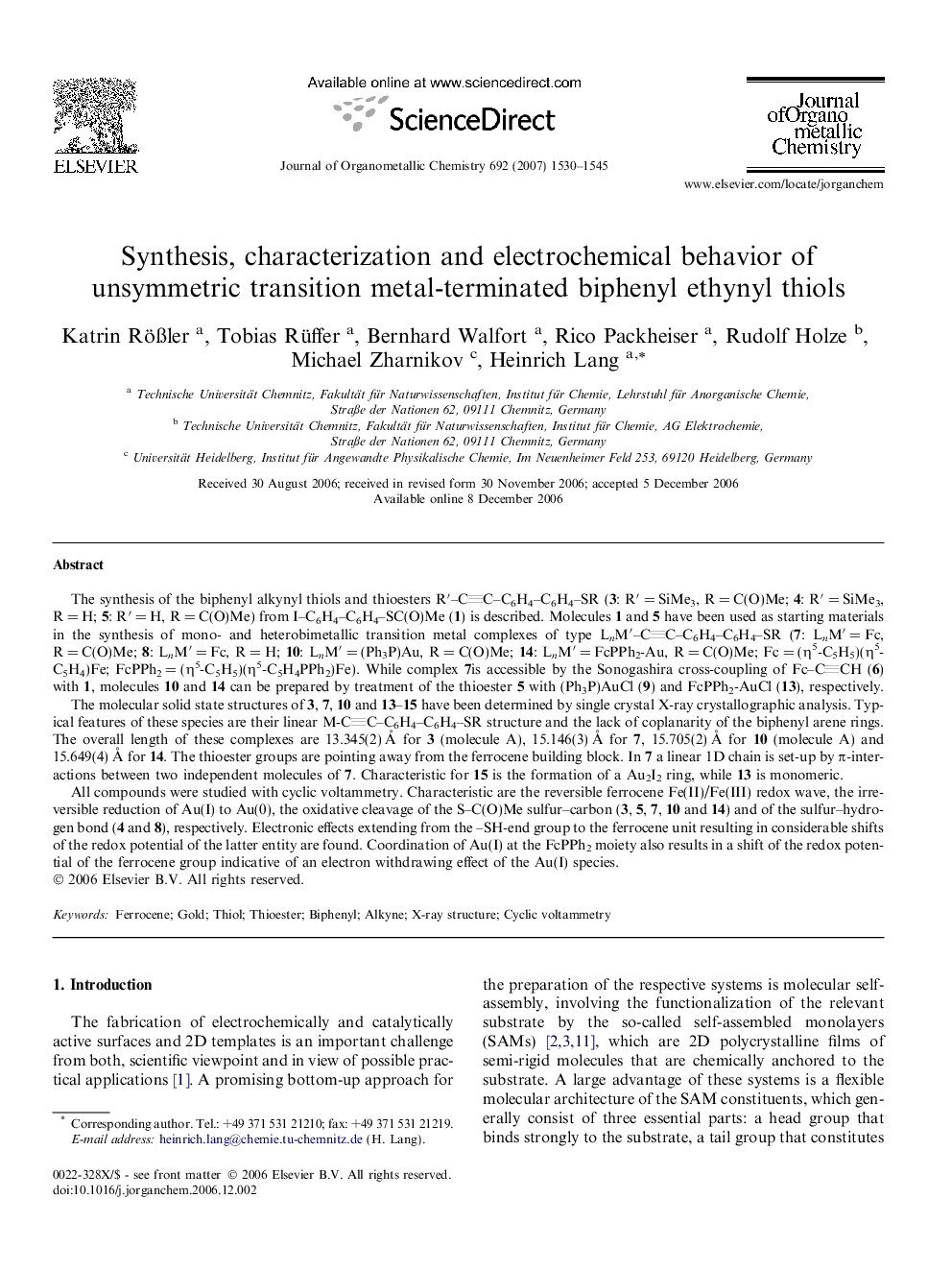| Article ID | Journal | Published Year | Pages | File Type |
|---|---|---|---|---|
| 1328270 | Journal of Organometallic Chemistry | 2007 | 16 Pages |
The synthesis of the biphenyl alkynyl thiols and thioesters R′–CC–C6H4–C6H4–SR (3: R′ = SiMe3, R = C(O)Me; 4: R′ = SiMe3, R = H; 5: R′ = H, R = C(O)Me) from I–C6H4–C6H4–SC(O)Me (1) is described. Molecules 1 and 5 have been used as starting materials in the synthesis of mono- and heterobimetallic transition metal complexes of type LnM′–CC–C6H4–C6H4–SR (7: LnM′ = Fc, R = C(O)Me; 8: LnM′ = Fc, R = H; 10: LnM′ = (Ph3P)Au, R = C(O)Me; 14: LnM′ = FcPPh2-Au, R = C(O)Me; Fc = (η5-C5H5)(η5-C5H4)Fe; FcPPh2 = (η5-C5H5)(η5-C5H4PPh2)Fe). While complex 7is accessible by the Sonogashira cross-coupling of Fc–CCH (6) with 1, molecules 10 and 14 can be prepared by treatment of the thioester 5 with (Ph3P)AuCl (9) and FcPPh2-AuCl (13), respectively.The molecular solid state structures of 3, 7, 10 and 13–15 have been determined by single crystal X-ray crystallographic analysis. Typical features of these species are their linear M-CC–C6H4–C6H4–SR structure and the lack of coplanarity of the biphenyl arene rings. The overall length of these complexes are 13.345(2) Å for 3 (molecule A), 15.146(3) Å for 7, 15.705(2) Å for 10 (molecule A) and 15.649(4) Å for 14. The thioester groups are pointing away from the ferrocene building block. In 7 a linear 1D chain is set-up by π-interactions between two independent molecules of 7. Characteristic for 15 is the formation of a Au2I2 ring, while 13 is monomeric.All compounds were studied with cyclic voltammetry. Characteristic are the reversible ferrocene Fe(II)/Fe(III) redox wave, the irreversible reduction of Au(I) to Au(0), the oxidative cleavage of the S–C(O)Me sulfur–carbon (3, 5, 7, 10 and 14) and of the sulfur–hydrogen bond (4 and 8), respectively. Electronic effects extending from the –SH-end group to the ferrocene unit resulting in considerable shifts of the redox potential of the latter entity are found. Coordination of Au(I) at the FcPPh2 moiety also results in a shift of the redox potential of the ferrocene group indicative of an electron withdrawing effect of the Au(I) species.
Graphical abstractThe synthesis, characterization and electrochemical behavior of R′–CC–C6H4–C6H4–SR (R′ = SiMe3, R = C(O)Me; R′ = SiMe3, R = H; R′ = H, R = C(O)Me) and LnM′–CC–C6H4–C6H4–SR (LnM = Fc, R = C(O)Me; LnM = Fc, R = H; LnM = (Ph3P)Au, R = C(O)Me; LnM = FcPPh2-Au, R = C(O)Me; Fc = (η5-C5H5)(η5-C5H4)Fe; FcPPh2 = (η5-C5H5)(η5-C5H4PPh2)Fe) is discussed. The solid state structures of six compounds are reported as well.Figure optionsDownload full-size imageDownload as PowerPoint slide
